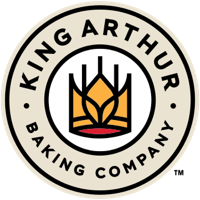Dough Temperature
One of the most important skills a baker must learn is the ability to accurately control dough temperature. The benefits are clear and immediate: more consistency in fermentation, in bread flavor, and more predictability in the overall production schedule.
Bread yeasts attain an optimum growth temperature in the mid-90°F range. One might think, therefore, that in order to favor yeast development, we should aim for bread dough in the mid-90s. This high temperature, however, would be at the expense of flavor development through the production of organic acids, which requires considerably lower temperatures. In general, wheat-based doughs should be between 75°F and 78°F at the end of mix time. Some exceptions to this guideline are naturally leavened breads that will ferment in a retarder, which could have a slightly lower dough temperature; and sourdough breads made with a high proportion of rye flour, which benefit from a dough temperature in the low to mid 80s.
If a dough is coming off the machine at 70°F one day and 80°F the next, we cannot expect to have uniformity in the results.
Water Temperature
The calculation of the water temperature that will result in the Desired Dough Temperature involves taking into consideration three or four factors (occasionally but rarely more than this). These factors are the variables over which we have no control when we enter the bakeshop and prepare to mix the dough:
- Air temperature
- Temperature of the flour
- The "friction factor" of our mixer (see below)
- Temperature of the preferment, if any
After figuring these, we can simply and quickly establish the correct water temperature (the only variable over which we have control). At the end of this discussion we will talk about friction factor in more detail.
Assume we have a desired dough temperature in mind. We will multiply this figure by 3 if we are mixing a straight dough, and by 4 if using a preferment. The result will be the total temperature factor. Once we have determined this factor, we subtract from it the sum of the known temperatures, and the result will be the required water temperature. Here are two examples:
| Straight Dough | With Preferment | |
| Desired Dough Temperature (DDT) | 76°F | 75°F |
| Multiplication Factor | x 3 | x 4 |
| TOTAL TEMPERATURE FACTOR (TTF) | 228 | 300 |
|---|---|---|
| Minus Flour Temperature | - 72° | - 68° |
| Minus Room Temperature | - 74° | - 68° |
| Minus Preferment Temperature | -71° | |
| Minus Friction Factor | - 24° | - 26° |
| REQUIRED WATER TEMPERATURE | 58° | 67° |
Friction Factor
As a dough spins, heat is generated by the friction caused by the action of the dough hook and bowl on the dough. Some factors that affect the amount of friction generated during mixing are the type of mixer being used (for example, spiral, oblique, or planetary), the length of mix time, mixing speeds used, and the quantity of dough that is in the machine. Ascertaining the friction factor for your mixer can be difficult indeed. It is the most difficult variable to quantify in the computation of desired dough temperature.
To determine the friction factor, first a trial dough is made. We take the temperature of the dough after mixing and use the results to calculate the friction factor. It is important to note the length of time the dough mixes, and on what speeds. If we alter these times and speeds, we will generate different amounts of friction. Here are two examples:
| Straight Dough | With Preferment | |
| Actual Dough Temperature (after mixing) | 78°F | 80°F |
| Multiplication Factor | x 3 | x 4 |
| TOTAL TEMPERATURE FACTOR (TTF) | 234 | 320 |
|---|---|---|
| Minus Flour Temperature | - 71° | - 68° |
| Minus Room Temperature | - 73° | - 68° |
| Minus Water Temperature | - 66° | - 85° |
| Minus Preferment Temperature | - 71° | |
| FRICTION FACTOR | 24° | 28° |

